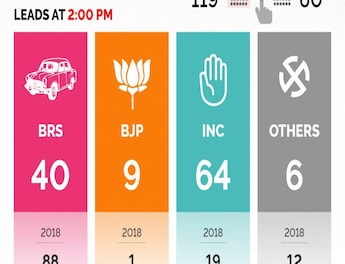A Closer Look at the Key Issues That Shaped the Election Results
By Sanjay Sharma
A Closer Look at the Key Issues That Shaped the Election Results
Intro
The recent elections across the world have been nothing short of eventful, with many nations witnessing major shifts in political power. From the surprising victory of Narendra Modi and his Bharatiya Janata Party in India to the tense races between opposing political parties in Europe and the United States, these elections have captivated the attention of the global community. As we analyze the results and try to make sense of the outcomes, it is crucial to take a closer look at the key issues that shaped these elections and ultimately determined the fate of different political parties. In this blog post, we will delve into some of the most pressing matters that influenced the election results and explore their impact on the current political landscape.
Analyzing the Role of Social Media in the 2020 Elections
Social media has emerged as a powerful force in shaping the outcomes of the 2020 elections. Platforms such as Facebook, Twitter, and Instagram have become crucial battlegrounds where political parties and candidates fight for the attention and support of voters. In the recent Rajasthan and Telangana elections, social media played a pivotal role in mobilizing voters and spreading campaign messages. Candidates and political parties used platforms like Twitter to engage directly with voters, share their vision, and counter Analyzing the Role of Social Media in the 2020 Election Opposition narratives. However, the impact of social media in the 2020 elections has not been all positive. The rise of fake news and misinformation on these platforms has also fueled election violence and deepened political divisions. The role of social media in shaping voters’ opinions cannot be underestimated, and understanding its influence is crucial in deciphering the election results. As we explore the other key issues in this blog post, we will analyze the specific ways social media impacted the political landscape during the 2020 elections.
In-depth Breakdown of Main Candidate’s Campaign Strategies
As we delve into the key issues that shaped the recent elections, it is essential to take an in-depth look at the campaign strategies employed by the main candidates. In the context of the Rajasthan and Telangana elections, candidates utilized various tactics to garner support and sway voters in their favor. One notable strategy was the emphasis on grassroots organizing, where candidates made direct connections with voters through rallies, door-to-door campaigns, and public events. This approach aimed to establish a personal connection with voters and address their specific concerns.
Additionally, both campaigns utilized traditional media, such as television and radio, to reach a broader audience. By leveraging these platforms, candidates were able to disseminate their messages and gain visibility. However, it is worth noting that while traditional media played a significant role, social media platforms also played a crucial part in these campaigns, allowing candidates to directly engage with voters and create a strong online presence.
The campaign strategies employed by the main candidates in these elections also reflected their responses to issues of election violence. As candidates addressed concerns around safety and security, their strategies focused on building trust and reassuring voters that they would take necessary measures to prevent any violence or intimidation. By acknowledging these concerns and outlining their plans for ensuring a peaceful election process, the candidates aimed to win the confidence of the electorate.
Understanding the Role of Media in Shaping Voters’ Opinions
The role of media in shaping voters’ opinions cannot be overlooked when analyzing the outcomes of the Rajasthan and Telangana elections. Media outlets, including newspapers, television channels, and online platforms, played a crucial role in influencing public sentiment and shaping the narrative around the candidates and their campaigns. The way in which the media portrayed the candidates, their policies, and their performance in previous elections significantly impacted voters’ perceptions and, ultimately, their voting decisions.
Media coverage of the Rajasthan and Telangana elections also had a significant impact on voter turnout and engagement. The extent to which the media covered election-related issues and provided comprehensive analysis influenced the level of public interest and awareness. In some instances, media outlets also played a role in highlighting instances of election violence, shedding light on important issues and potentially influencing public opinion on matters of safety and security.
It is essential to analyze the media’s role in shaping voters’ opinions to gain a comprehensive understanding of the factors that contributed to the election results. By critically examining the way in which the media covered the campaigns, it becomes possible to assess the extent to which media bias, sensationalism, or misinformation influenced voters’ decision-making processes. The media’s responsibility in shaping the political landscape cannot be understated, and it is crucial to understand how it impacts voters’ opinions in order to foster an informed and democratic society.
Exploring the Impact of Voter Turnout and Demographic Factors
Voter turnout and demographic factors are two crucial aspects that greatly impact election results. In the recent Rajasthan and Telangana elections, these factors played a significant role in shaping the political landscape. The level of voter turnout reflects the engagement and enthusiasm of the electorate, as well as their confidence in the democratic process. Higher voter turnout often indicates a greater sense of civic duty and involvement, while lower turnout can signify disinterest or dissatisfaction.
Demographic factors, such as age, gender, and socioeconomic status, also heavily influence election outcomes. Different demographics may have varying priorities and concerns, leading them to support different candidates or political parties. Understanding the demographics of the electorate is crucial in deciphering the reasons behind the election results and identifying any patterns or trends.
By exploring the impact of voter turnout and demographic factors in the Rajasthan and Telangana elections, we can gain valuable insights into the preferences and motivations of the electorate and gain a deeper understanding of the political landscape.
Deciphering Key Economic Issues Influencing the Elections
As we delve into the key issues that shaped the recent elections in Rajasthan and Telangana, it is crucial to examine the economic factors that played a significant role in influencing the outcome. The state of the economy is often a key concern for voters, as it directly impacts their livelihoods and quality of life. In both the Rajasthan and Telangana elections, the main candidates were evaluated based on their proposed economic policies and their track record in promoting economic growth and development.
One of the key economic issues that influenced the elections was job creation. Unemployment rates and the availability of job opportunities were major concerns for voters. Candidates who presented credible plans for creating employment opportunities and addressing the issue of joblessness gained the support of the electorate.
Another important economic issue was agricultural policies. In both Rajasthan and Telangana, agriculture plays a crucial role in the economy. Candidates who promised to implement effective agricultural policies, such as providing better irrigation facilities, crop insurance, and access to credit for farmers, gained the trust and support of rural voters.
Infrastructure development was also a key economic issue in these elections. Candidates who emphasized the need for improving infrastructure, such as roads, bridges, and electricity, resonated with voters who saw the potential for economic growth and improved living standards.
Overall, deciphering the key economic issues that influenced the elections in Rajasthan and Telangana provides valuable insights into the concerns and priorities of the electorate. It highlights the importance of addressing economic issues and implementing effective policies to secure the support of voters and shape the political landscape.
The Future Political Landscape: Implications of the Election Results
The outcomes of the Rajasthan and Telangana elections have far-reaching implications for the future political landscape of these regions. The election results have not only determined the immediate composition of political power but have also provided insights into the preferences, concerns, and priorities of the electorate.
In Rajasthan, the victory of the Bharatiya Janata Party (BJP) signifies the continued dominance of the party in the state, highlighting the appeal of their policies and leadership. This outcome may further solidify the BJP’s position and influence in the region, shaping the political landscape for years to come.
Similarly, in Telangana, the triumph of the Telangana Rashtra Samithi (TRS) indicates the popularity and effectiveness of their governance, reinforcing their position as the leading political force in the state. The election results reflect the confidence of voters in the TRS and may contribute to the consolidation of their power in the coming years.
The implications of these election results go beyond the immediate political sphere. They provide crucial insights into the key issues and concerns that resonate with voters in these regions. By understanding the implications of the election results, policymakers can tailor their strategies and policies to address the needs and aspirations of the electorate, shaping a future political landscape that truly reflects the will of the people.







